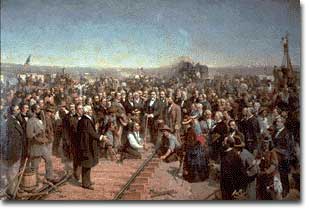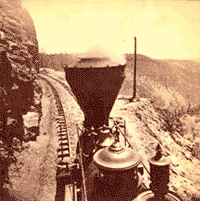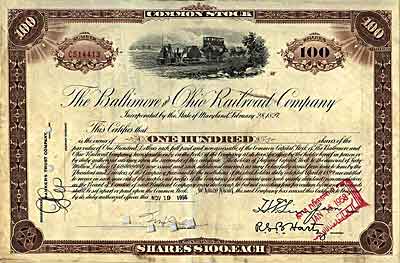25b. Early American Railroads

In 1869, a golden spike linked the Central Pacific Railroad and the Union Pacific Railroad at Promontory, Utah.
The development of railroads was one of the most important phenomena of the Industrial Revolution. With their formation, construction and operation, they brought profound social, economic and political change to a country only 50 years old. Over the next 50 years, America would come to see magnificent bridges and other structures on which trains would run, awesome depots, ruthless rail magnates and the majesty of rail locomotives crossing the country.
The railroad was first developed in Great Britain. A man named George Stephenson successfully applied the steam technology of the day and created the world's first successful locomotive. The first engines used in the United States were purchased from the Stephenson Works in England. Even rails were largely imported from England until the Civil War. Americans who had visited England to see new steam locomotives were impressed that railroads dropped the cost of shipping by carriage by 60-70%.

This stereograph of the Central Pacific Railroad would have appeared three-dimensional when viewed through special glasses.
Baltimore, the third largest city in the nation in 1827, had not invested in a canal. Yet, Baltimore was 200 miles closer to the frontier than New York and soon recognized that the development of a railway could make the city more competitive with New York and the Erie Canal in transporting people and goods to the West. The result was the Baltimore and Ohio Railroad, the first railroad chartered in the United States. There were great parades on the day the construction started. On July 4, 1828, the first spadeful of earth was turned over by the last surviving signer of the Declaration of Independence, 91-year-old Charles Carroll.
New railroads came swiftly. In 1830, the South Carolina Canal and Rail-Road Company was formed to draw trade from the interior of the state. It had a steam locomotive built at the West Point Foundry in New York City, called The Best Friend of Charleston, the first steam locomotive to be built for sale in the United States. A year later, the Mohawk & Hudson railroad reduced a 40-mile wandering canal trip that took all day to accomplish to a 17-mile trip that took less than an hour. Its first steam engine was named the DeWitt Clinton after the builder of the Erie Canal.
Although the first railroads were successful, attempts to finance new ones originally failed as opposition was mounted by turnpike operators, canal companies, stagecoach companies and those who drove wagons. Opposition was mounted, in many cases, by tavern owners and innkeepers whose businesses were threatened. Sometimes opposition turned to violence. Religious leaders decried trains as sacriligious. But the economic benefits of the railroad soon won over the skeptics.

Shares were sold to fund the construction of the B&O Railroad. In only 12 days, the company had raised over $4,000,000.
Perhaps the greatest physical feat of 19th century America was the creation of the transcontinental railroad. Two railroads, the Central Pacific starting in San Francisco and a new railroad, the Union Pacific, starting in Omaha, Nebraska, would build the rail-line. Huge forces of immigrants, mainly Irish for the Union Pacific and Chinese for the Central Pacific, crossed mountains, dug tunnels and laid track. The two railroads met at Promontory, Utah, on May 10, 1869, and drove a last, golden spike into the completed railway.







